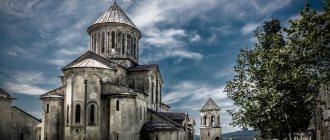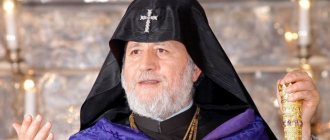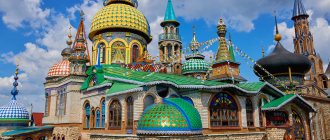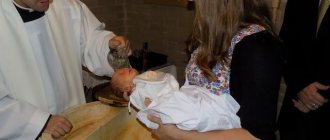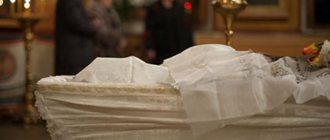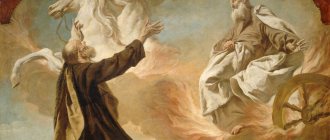| Patriarch-Catholicos of All Georgia Ilia II |
Ilia II (Gudushauri-Shiolashvili)
(born 1933), Catholicos-Patriarch of All Georgia, Archbishop of Mtskheta and Tbilisi and Metropolitan of Pitsunda and Sukhumi-Abkhazia In the world Gudushauri-Shiolashvili (Georgian: ღუდუშაური-ში ოლაშვილი) Irakli Georgievich, born January 4, 1933 in the city of Ordzhonikidze (now Vladikavkaz), North Ossetian Autonomous Okrug, RSFSR, USSR. His parents were from the Kazbegi region: his father, Georgy Simonovich Shiolashvili, from the village of Sno, his mother, Natalya Iosifovna Kobaidze, from the village of Sioni. In 1927, they purchased a house in Vladikavkaz, where the future patriarch was later born. The newborn was baptized on the day of the Nativity of Christ in a Georgian church. The baby was named Irakli in honor of the Georgian king Irakli II.
In 1952 he graduated from the 22nd secondary school in the city of Ordzhonikidze and entered the Moscow Theological Seminary, which he graduated in 1956, and then continued his studies at the Moscow Theological Academy.
On April 16, 1957, as a 2nd year student at the academy, he was tonsured a monk with a name in honor of the holy prophet Elijah. Elder Bishop Zinovy (Mazhuga) performed tonsure in the Tbilisi Church of St. Alexander Nevsky, who then predicted his future patriarchal service.
On April 18 of the same year, he was ordained as hierodeacon by Catholicos-Patriarch Melchizedek in the Zion Dormition Cathedral.
On May 10, 1959, he was ordained hieromonk by Patriarch Alexy of Moscow and All Rus'.
In 1960 he graduated from the Moscow Theological Academy, and for his essay on the topic “History of the Athos Iveron Monastery” he was awarded the degree of candidate of theology. After graduating from the academy, he returned to his homeland and was appointed cleric of the Cathedral of Batumi.
In 1961 he was elevated to the rank of abbot, and then archimandrite.
| Metropolitan Abkhazian Ilia (Gudushauri-Shiolashvili) |
On August 26, 1963, he was consecrated Bishop of Shemokmed, vicar of Catholicos-Patriarch Ephraim II.
From 1963 to 1972, he served as the rector of the Mtskheta Theological Seminary, which at that time was the only theological school in Georgia.
In 1967 he was transferred to the Abkhaz See, and in 1969 he was elevated to the rank of Metropolitan.
On December 23, 1977, he was elected Catholicos-Patriarch of All Georgia. The ceremony of enthronement of Ilia II took place on December 25 of the same year.
In 1978-1983 he was president of the World Council of Churches. In 1997, the Georgian Orthodox Church left this organization.
| Patriarch-Catholicos of All Georgia Ilia II |
During the patriarchal service of Ilia II, the number of dioceses of the Georgian Church increased from 15 to 27, the number of monasteries - to 53, the number of existing churches - from 50 to 800 [1].
New saints were glorified, new religious educational institutions were opened. The largest temple in Georgia was built in Tbilisi - the Cathedral in the name of St. Trinity. Since the late 1980s, during difficult periods of political restructuring for Georgia, Ilia II has made fruitful efforts to mitigate tensions between different political forces; the authorities, the opposition, public organizations, and the general population listen to his opinion. Thus, in November 2007, he contributed to normalizing the situation and establishing a dialogue between the authorities and the opposition, and then called on the people of the country to take part in the elections on January 5, 2008. On December 21, 2010, he assumed direct control of the Sukhumi diocese, and therefore received a prefix to the title “Metropolitan of Pitsunda and Sukhumi-Abkhazia.”
On November 23, 2022, in the Tbilisi Zion Cathedral of the Assumption of the Blessed Virgin Mary, a decree was read out on the appointment of Metropolitan Shio (Mujiri) of Senaki as locum tenens of the patriarchal throne [2].
Poisoning scandal
Rumors that they tried to kill Ilia II appeared on February 12. The Georgian TV channel Rustavi 2 reported that the patriarch could have been poisoned by attackers - moreover, the shadow fell on his own subordinates. The head of the Patriarchate's property management service and the director of the medical center of Saints Joachim and Anne, Father Mamaladze, was detained on charges of preparing a crime. He allegedly tried to smuggle poison - cyanide - to Berlin, where Ilia II was being treated. Later, these reports were officially confirmed by the Georgian Prosecutor's Office.
“The investigation into this case was launched on February 2, 2022, based on a statement from a citizen who contacted the prosecutor’s office and reported that his acquaintance, priest Georgy Mamaladze, asked him to help purchase the deadly substance cyanide, which Mamaladze, as the applicant found out in a personal conversation with a suspect, he was going to kill a clergyman of the highest hierarchy,” said Georgia’s chief prosecutor Irakli Shotadze.
According to him, it was established that “Mamaladze, who is also the general director of the treatment center at the patriarchate, due to his official duties, systematically communicated with the patriarch and members of his inner circle.”
Who is suspected?
The Georgian prosecutor's office announced the detention of Georgy Mamaladze on February 13 at an emergency briefing. The priest was captured on February 10 at Tbilisi International Airport, from where he was planning to deliver poison to Germany. During a search, sodium cyanide was found in his luggage. A firearm was also seized from the priest's apartment. The Tbilisi City Court, at a closed meeting, issued a warrant for the arrest of Mamaladze. The duration of the suspect's detention is not specified.
In connection with the incident, a criminal case under the articles “Preparation for premeditated murder” and “Illegal acquisition, storage, carrying, manufacturing, transportation, shipment or sale of firearms, ammunition, explosives or explosive devices.” The sanction provides for punishment in the form of imprisonment for a term of 7 to 15 years. Currently, Georgian law enforcement agencies are establishing all the details of this story. Several versions are being considered. The motives of Georgy Mamaladze still remain a mystery.
"Answer"
Metropolitan Peter (Tsaava) was expelled from the Synod meeting, during which he almost attacked the 86-year-old Patriarch Ilia II with his fists.
Photo: Wikimedia Mamaladze cannot answer Jacob, but another “accused” answered him, Metropolitan Peter (Tsaava), and very effectively, with a fight at an extraordinary meeting of the Synod in Tbilisi on October 31. It is noteworthy that, unlike his opponent, Peter has a reputation as a pro-Western and pro-Constantinople hierarch. At the meeting, he stated that there is an influential “blue lobby” in the Synod, covered by Ilia II, whom Peter also called a “sodomy.” At the same time, according to other participants in the meeting, he tried to attack the elder, so that other bishops had to restrain the temperamental metropolitan and forcefully remove him from the Synod.
Peter was immediately released from the administration of the diocese and exiled to a monastery to repent.
There he was found by the body, to whom the demoted hierarch said a lot of “compromising evidence.” According to Peter, Ilia II is not only a “sodomy”, but also a connoisseur of pornographic products, which were allegedly supplied to him by the convicted Archpriest Mamaladze. The Metropolitan also expressed political accusations - that “Ilia the Second unconditionally submits to the Russian Patriarch Kirill,” with whom he is part of the circle of disciples of the late Metropolitan Nikodim (Rotov), and collaborates with the Democratic Movement - United Georgia party of Nino Burjanadze. Metropolitan Peter rejected suspicions that he himself was working for Bidzina Ivanishvili and was trying to drown out the statements of Metropolitan Iakov with his loud revelations.
This scandal immediately spilled over into big politics. The leader of the opposition National Movement faction in parliament, Roman Gotsiridze, demanded that the authorities investigate charges of conspiracy against the patriarch. And when the authorities refused to create an investigative commission, he concluded: “This is direct confirmation that the [ruling party] Georgian Dream was preparing an unprecedented coup to overthrow the patriarch.” On the second attempt, in mid-November, the Georgian parliament began to form a special investigative commission on this case.
In turn, Georgian Ombudsman Nino Lomjaria called for an investigation into allegations of sexual crimes by Georgian hierarchs, which, in her words, “could have been committed against minors.” She called on affected citizens to contact law enforcement agencies with relevant complaints without fear.
Metropolitan Zosima of Tsilkan (pictured) was accused of harassing seminarians. The son of a key witness in the case suddenly hanged himself in his Tbilisi apartment. Photo: Wikimedia
This call and the events preceding it raised a media wave. Priest Georgiy Skhiladze accused Metropolitan Zosima (Shioshvili) of Tsilkansky of harassing seminarians, who in the past, since Soviet times, was the rector of the Mtskheta Theological Seminary and a close associate of Ilia II. Father George allegedly appealed to the church court, where he was ready to present witnesses, but Ilia II blocked the proceedings.
Against the backdrop of a growing scandal, on the morning of November 7, Bishop Iason (Tsamalaidze), the son of Bishop Christopher, who had been excommunicated from the Georgian Patriarchate, was found hanged in a Tbilisi apartment. Like Peter, Bishop Christopher also accused other hierarchs of “sodomy,” for which he was excommunicated back in 1995. The fact is that Christopher is a key link in the chain of evidence from the prosecution against Metropolitan Zosima, since he has the written testimony of the injured seminarian.
In connection with the mysterious death of the bishop, a case has been opened under the article “incitement to suicide,” and Christopher is still silent.
The Patriarch's security has been strengthened
The Primate of the Georgian Orthodox Church is currently undergoing treatment in Berlin. At the end of 2016, he suffered a viral infection that caused inflammation of the gallbladder. Due to his condition, Ilia II was unable to attend several important events. Having initially refused the services of foreign doctors, the patriarch nevertheless agreed to go to Berlin for examination.
“According to information received from Germany, clinical, laboratory and instrumental studies of the patriarch were completed on February 8. Based on the data obtained, the need for surgical treatment of the gallbladder was confirmed,” the press service of the Georgian Patriarchate said in a statement. On February 13, German doctors successfully operated using laparoscopy. In just a week, the head of the Georgian Church should be discharged.
Amid reports of an attempted poisoning, the security of Ilia II was strengthened . Almost immediately after Mamaladze’s arrest, the head of the State Security Service, Anzor Chubinidze, went to Berlin on behalf of Georgian Prime Minister Giorgi Kvirikashvili. At his request, the head of the patriarch's security service, Soso Okhanashvili, flew to Georgia for interrogation and later returned. The conversation lasted about four hours and the investigation did not have any questions for Okhanashvili. Thus, now the safety of Ilia II in Germany is ensured not only by the personal security service, but also by the state one.
The head of the Georgian Orthodox Church himself does not believe that someone planned to poison him. The primate’s reaction was conveyed by Metropolitan Father Nikoloz, who is in a Berlin clinic.
“I will express my opinion and the opinion of the patriarch. I don’t believe that there is a person in Georgia who could have such thoughts. Nobody knows what happened. The Patriarch does not believe in this either. I’ve only read in books about someone poisoning someone,” RIA Novosti quotes the metropolitan.
Let us recall that Ilia II was born on January 4, 1933 in Vladikavkaz, he studied at the Moscow Theological Seminary and Academy. He is the head of the Georgian Orthodox Church on December 23, 1977.
ILIAH II
At the time of I.’s enthronement, the highest hierarchy of the GOC was represented by 7 bishops; There were 15 dioceses (including 5 dowagers), 34 churches (were registered) and 4 monasteries (not registered). Due to the pressure of Soviet ideological propaganda, there was almost no flock, and there was no liturgical and spiritual literature. Already in the next year, 1978, I. consecrated 4 new bishops; Celebrations were held to mark the 1500th anniversary of the creation of the 1st cargo. hagiographic work - The Martyrdom of St. Shushanik; Church delegations from the USA, K-pol, Antioch, and Mount Athos visited Georgia. As of Jan. In 1979, there were already 46 registered churches operating in Georgia, and there were up to 80 clergy and clergy.
Paying special attention to the education of the flock, I. determined that every Tuesday evening in Tbilisi Sioni 3 sermons would be read, one of which he himself would always deliver. 8 Feb. 1978 at a meeting of the Priest. The Synod of the GOC decided to create the Publishing Department of the Patriarchate and publish the official periodical publication of the GOC. On March 23, 1978, at a meeting of the Council for Religious Affairs, the publication of the church calendar was authorized in 2 types: wall sheet and folding pocket with a total circulation of 5 thousand copies. Since 1979, circulation of 1 thousand copies. began to come out “Jvari Vazisa” (Cross of the Vine).
A Sunday school was opened at the Tbilisi Sioni, where classes were held on a voluntary basis in groups to teach church reading, choir singing, and handicrafts. Representatives of youth, despite pressure from the authorities, who threatened expulsion from the university and dismissal from work, performed the obediences of readers, subdeacons, teachers, scribes, cleaners, etc. for free. I.’s popularity among believers and respect for him attracted even members of high-ranking families cargo. party workers, who began to secretly visit Sioni. The number of believers in other churches also increased significantly: for example, 5 thousand people came to the Sukhumi Cathedral on Easter 1978 (April 29), while in previous years there were no more than 1.5 thousand at the service .believers.
Elijah, Metropolitan Sukhumi-Abkhazian, Locum Tenens of the Patriarchal Throne, at the XII Local Council of the Georgian Orthodox Church in Tbilisi Sioni. Photo. 23 Dec 1977 Elijah, Met. Sukhumi-Abkhazian, Locum Tenens of the Patriarchal Throne, at the XII Local Council of the Georgian Orthodox Church in Tbilisi Sioni. Photo. 23 Dec 1977 The secular authorities did not ignore the changes taking place in the GOC: in the report of the Commissioner of the Council for Religious Affairs for the Georgian SSR T. Onoprishvili for 1979, extreme concern was expressed about the active actions of the First Hierarch, who strengthened the episcopate of the GOC and attracted new cadres to the priesthood. The document specifically noted that in the reporting year, the 1st year of the Mtskheta DS was completed for the first time (16 full-time and 7 part-time students), 8 students studied in the 2nd year, 5 students studied in the 3rd year; The GOC sent seminarians to study at the MDS and MDA, to the Leningrad DS, to the theological faculty of the University of Athens. I. was strongly recommended to reduce the number of services he held and sermons he preached; Onoprishvili was relieved of his position due to “unsatisfactory performance.”
During the 2 years of I.'s Patriarchate, 34 clergy were ordained, despite the fact that the choice of a spiritual career at that time was considered humiliating. I. continued to petition for the registration of actually operating churches and Mont-Rei and for the opening of temples, the buildings of which were occupied by Soviet infrastructure. In 1980, he sent a petition to the Council for Religious Affairs to open the most significant spiritual centers for the GOC: the Tbilisi churches of St. Nicholas, martyr George, Jvarismama, Bolnisi, Metekhi, Anchiskhati, Lurji monastery and others, the katholicons of mon-ray Kvatakhevi, Shemokmedi, Shiomgvime, Zarzma, Sapara, Gelati, Ikalto, Martvili, Davidgareji, temples of Ananuri, Tsaishi, Gremi, Ertatsminda, Samtavisi, Kintsvisi , Tsromi, Barakoni, Bolnisi Zion, Ateni Sioni, Zugdidi, etc. There were 5 monasteries in Georgia (not all were registered by the Department of Religious Affairs): Betania (male), Samtavro, Olginsky, Jiketi, Teklati (female). I. wrote to the Chairman of the Government of the Georgian SSR: “It is not clear why it was not taken into account that the Shiomgvime monastery is active, which has a rector, and divine services did not stop there? The question is raised, what does the organ have to do with the Georgian monastery? Let us consider the situation of other churches: in the Metekhi Church, where St. VMC. Shushanik (5th century), - youth theater, performances with dances are held; in the magnificent Pitsunda Church, where the cathedra of the Catholicos-Patriarch in Western Georgia was located, there is an organ and concerts are held, the Church of St. Nicholas in Tbilisi was also turned into a concert hall, in the Anchiskhat Patriarchal Church - a workshop, in the Church of the Virgin Mary in Nadzaladevi - a bathhouse, in the Tskhneti Church - a bakery. In the cities and regions of Georgia, many churches and monasteries have been turned into warehouses, places of public entertainment and recreation.”
Commissioner of the Council for Religious Affairs G. Maisuradze in a report dated November 9. 1987 again pointed out that the GOC has a special influence on young people, which is due to “the arrival of the young, energetic, more educated, intelligent and flexible Ilya II.” Maisuradze also noted that, despite the limited capabilities of the GOC to publish church literature, “this situation is used rationally... the main orienting tool for believers is a desktop calendar in the amount of 25-27 printed sheets.” Soon the Theological Collection began to be published. Since 1990, church gas has been published. "Madli" (Grace), since 1999 - gas. “Sapatriarkos Utskebani” (Gazette of the Patriarchate). Under the auspices of the Publishing Department of the Georgian Patriarchate, scientific works and textbooks, theological literature began to be published, and original ancient monuments were published. church literature and translated works.
Catholicos-Patriarch Ilia II. Photo. 1979
Catholicos-Patriarch Ilia II. Photo. 1979
In 1985, I. obtained permission from the Council of Religious Affairs to publish the Bible translated into modern times. cargo. language. The Bible was published in 1989. On June 26-30, a scientific symposium was held in Tbilisi on the problems of Bible translation, in which representatives of the Bulgarian, Polish, Finnish, and Greek Local Churches, scientists from Bible translation institutes (Sweden, Great Britain) and Bible societies (France, Greece, Germany, USA).
The change in the political course of the USSR in 1988 also affected the position of the GOC. During this year, 45 churches were opened. On the territory of the Azerbaijan SSR, under the jurisdiction of the GOC, 2 priests and a psalm-reader served in the church in the city of Kakhi; on the territory of the Armenian SSR, 2 churches were restored, where 2 priests served. In the same year, the Tbilisi Theological Academy opened, in which I. was supported by Commissioner for Religious Affairs A. Tsiklauri. The Mtskheta DS was moved to Tbilisi and was located in the same building as the DA. In a speech at the academy's opening ceremony on October 1. And about.
In 1994, the Theological Institute began to function under the Tbilisi DA. Training at the institute is conducted in 3 departments: psychology and religious studies, art history and pedagogy, icon painting and restoration. On May 25, 1995, the Gelati Academy, founded by St., resumed work in Kutaisi. by King David IV the Builder at the Gelati monastery and was widely known in the Middle Ages. Prominent cargo became members of the new academy. scientists. Theological educational institutions opened in Kutaisi, Akhaltsikhe, Batumi (DS); in Poti, Kvareli, Kobuleti, Gori, Zugdidi, Tskaltubo (theological gymnasiums). In 2007-2008 under the Georgian Patriarchate, courses for nurses and higher education began. a school for church choir directors, a college of ecology and landscaping, beekeeping courses, schools of icon painting, cloisonne enamel, stone and wood carving, and handicrafts. In 2008, under the Georgian Patriarchate, the secular Georgian University was founded. St. ap. Andrew the First-Called.
Since 1999, the radio station of the Patriarchate of Georgia “Iveria” has been broadcasting to all major cities of the country, which are also broadcast via satellite and the Internet. In 2007, the Patriarchate began broadcasting on its own TV channel “Iveria” (since 2009 “Ertsulovneba” (Unanimity)).
On I.’s initiative, during the years of his primacy, many were canonized. saints who became famous both in antiquity and in the 19th-20th centuries, among them - rights. Ilia Chavchavadze (canonized July 20, 1987); Catholicos-Patriarch of Georgia smch. Ambrose (Helaya), sschmch. Nazarius (Lezhava) and those who suffered with him, Saints Gabriel (Kikodze) and Alexander (Okropiridze), smch. Gregory (Peradze), Venerable Alexy (Shushaniya), sschmch. Theodore Kvelteli (September 18-19, 1995); parents of St. equal to Nina the Venerables Zebulon and Sosanna (Dec. 23, 1996); martyr Tsotne Dadiani (26 Oct 1999); sschmch. Kirion III (Sadzaglishvili), St. Zosim Kumurdoysky, schmch. Theodore Achareli, Venerable Hilarion Gruzin (Kanchaveli), Klarjet Reverend Fathers and Wives, Righteous Tbeli Abuseridze and Evfimy Takaishvili (Oct 18, 2002); Laz martyrs, Spanish. Evfimy (Kereselidze), Bethany monks John (Maisuradze) and John-George (Mkheidze) (Aug. 18, 2003); St. George Chkondideli, Metropolitan Hieromartyrs Dosifei (Tsereteli) and Evfimy (Shervashidze), smch. Demetrius Kipiani, King of Imereti St. Solomon II (June 27, 2005); king martyr Vakhtang III (Dec. 23, 2005), etc.
Catholicos-Patriarch Ilia II performs a divine service on the day of the transfer of the relics of St. King Solomon II in Gelati Monastery. Photo. 1990
Catholicos-Patriarch Ilia II performs a divine service on the day of the transfer of the relics of St. King Solomon II in Gelati Monastery. Photo. 1990
In 1979 and 1995 in the Patriarchal Cathedral of Svetitskhoveli I. performed the rite of consecration of St. peace. Religious processions have become traditional in places where the enlighteners of Georgia - St. ap. Andrew the First-Called (from Adjara to Mtskheta) and St. equal to Nina (from Lake Paravani to Mtskheta).
Oct 14 2002 in Svetitskhoveli, the President of Georgia E. Shevardnadze and I. signed a concordat - the Constitutional Agreement of the Georgian Orthodox Church with the state, the second most important law of the country after the Constitution of Georgia, regulating relations between the Church and the state (for more details, see article Georgia ).
A very significant event that occurred during the period of I.’s patriarchal service was the construction in Tbilisi, timed to coincide with the 2000th anniversary of the Nativity of Christ, of a new patriarchal cathedral, the Sameba Lavra (Holy Trinity; 1995-2004), with public donations and funds from patrons. This largest cathedral in Georgia and one of the largest in the Orthodox world (77 × 65 sq. m, height 68 m) has 11 altars.
At the solemn liturgy after the consecration of the cathedral (November 23, 2004), I. concelebrated with the bishops and clergy of the Polish, Alexandrian, Antiochian, Russian, Serbian, Romanian, Cypriot, Greek, Polish, Albanian Orthodox Churches, as well as the Orthodox Church in America. I. called Sameba “a self-portrait of the Georgian people.”
8 Feb. 2005, on the day of veneration of St. King David IV the Builder, I. established the International Charitable Foundation of the Catholicos-Patriarch of Georgia “Revival and Development of Spirituality, Culture and Science”. Under him, the International Cargo Center was founded in 2006. church music and folk songs. The Catholicos-Patriarch's Foundation has identified support for the implementation of preventive measures in the fight against drug addiction as one of its main activities.
I. pays special attention to issues of mercy. He issued a decree in which he called on believers to dedicate every Saturday to their neighbors: to visit the sick, prisoners, and the disadvantaged and, if possible, to help them in word or deed. In April 1990 I. sent a written appeal to the President of the USSR M. S. Gorbachev with an appeal to abolish the death penalty and replace it with another punishment, to show mercy to those who realized their mistakes, repented and are ready for correction. I. regularly visits places of detention, meets and talks with prisoners. Almost all places of detention in Georgia have prayer rooms or corners; At the request of the prisoners and with their help, temples are built. Juvenile prisoners show a particular interest in faith.
At the insistence of I., recently clergy have been allowed not only to visit prisoners, but also to petition for their pardon, which has enabled the Catholicos-Patriarch and the GOC as a whole to grant freedom to hundreds of prisoners; such liberated ones lead Christ. way of life, regularly receive communion and are not known to commit serious crimes. With I.’s blessing, in 2002 the institution of regimental priests was restored in Georgia, which, in the opinion of the Catholicos-Patriarch, “will greatly contribute to the spiritual elevation of military personnel.”
Catholicos-Patriarch Ilia II on a high place in the Patriarchal Cathedral of Sameba in Tbilisi. Beginning XXI century
Catholicos-Patriarch Ilia II on a high place in the Patriarchal Cathedral of Sameba in Tbilisi. Beginning XXI century
I. shows special care towards children deprived of parental care and elderly people without shelter. In the 90s XX century nuns searched the streets for children who had lost their parents during the civil war in Georgia. Orphans found shelter in Tbilisi's Preobrazhensky Women's Centre. monastery Later, the GOC orphanage was opened at the Dzegvi monastery. The Church monitors the fate of orphans even after they are released from the orphanage. Patriarchal orphanages were opened in Akhalkalaki, Batumi, Bediani, Sachkhere, and Surami. Free canteens were also founded for all those in need, regardless of their nationality and religion. Under the auspices of the GOC, associations of mothers who have lost children have been created; members of such families support each other spiritually and financially, which allowed many of them to overcome the crisis and start a new life.
I. is always at the epicenter of all events taking place in the country. Apr 9 1989, during a mass rally in Tbilisi on Rustaveli Avenue in front of the building of the Government of the Georgian SSR (now the Parliament), where there were calls for Georgia to secede from the USSR, I., concerned that Soviet military units were converging on the avenue, at 3 o’clock . nights came out to the protesters and called on the people to pacify, insisting that the demonstrators go with him to pray at the nearby church. Kvashveti. However, most of the rally participants did not heed his words; As a result of a clash with military units, 19 people were killed. I.’s personality and his participation in the events played a significant role in overcoming the pain of the tragedy of April 9 by the Georgian people, declared the Day of Sorrow in Georgia, and the following days.
On Dec. 1991 - Jan. In 1992, civil war broke out in the country. I. tried to reconcile the warring parties and agreed to hold negotiations between them in the Patriarchate. The meetings had a definite result, although it was still not possible to avoid a collision. This difficult period of ethnic conflicts for Georgia led to destruction, casualties and the cessation of long-term ties between Georgians and Abkhazians and Georgians and Ossetians, as well as military actions between Georgia and Russia in August. 2008
However, despite this, the GOC and the Russian Orthodox Church maintained friendly relations, i.e. showing the world community that Orthodoxy is the basis on which the future peaceful coexistence of 2 neighboring sovereign states is possible. With the assistance of Patriarch of Moscow and All Rus' Alexy II and Chairman of the DECR of the Russian Orthodox Church, Metropolitan. Smolensk and Kaliningrad Kirill (Gundyaev; now Patriarch of Moscow and All Rus') I. was able to take the bodies of the victims out of the conflict zone (Tskhinvali region), giving the relatives the opportunity to bury them according to the Orthodox Church. custom. I. actively participated in negotiations and the procedure for the release of prisoners of war.
I. pays special attention to the issue of correcting the demographic situation in Georgia. The Catholicos-Patriarch addressed the residents of Georgia with a new initiative: “If the parents wish, the Catholicos-Patriarch personally will become the godfather of every third child of any family, regardless of their ethnicity.” The first such baptism took place on January 19. 2008 in Sameba. At the moment, 8 baptisms have taken place (the last one was on September 28, 2009). I. already has 3.7 thousand godchildren. The increase in the number of registered marriages and birth rates in Georgia, which has been observed over the past 2 years, is qualified by experts as a demographic boom, the main factor of which they call the initiative of I.
As of con. In 2009, through the efforts of I., the composition of the highest clergy of the GOC increased to 39 bishops; The jurisdiction of the Church includes the same number of dioceses. Five of the dioceses established under I. were restored in the historical territories of Georgia (Lazeti, Tao-Klarjeti, Hereti, Tashiri), which now belong to Armenia, Azerbaijan and Turkey: these are Akhaltsikhe-Tao-Klarjeti, Batumo-Laz, Dmanis-Agarak-Tashir, Dedoplistskaro -Nekres and Eret dioceses. 17 Oct 2002 for Western parishes. Europe, the Western European Diocese was established. During I.'s leadership, over 1.5 thousand churches and 170 monasteries were opened, where 3.2 thousand clergy served.
A letter of revelation?
A letter that Mamaladze allegedly sent to Ilia II two months before his arrest also added fuel to the fire. In his message, the clergyman says that the Georgian patriarchate is mired in corruption. In particular, we are talking about a debt of 110.5 million rubles, which accumulated as a result of fraud. Also, according to media reports, the letter states that companies owned by the patriarchy are allegedly engaged in commerce, including the production of alcohol and trading in oil. At the same time, Mamaladze asks the patriarch for his blessing to conduct an audit. The authenticity of the letter is still in doubt among many.
Assassination as a blow to Georgia
reacted sharply to the attempted assassination of Ilia II . The country's President Giorgi Margvelashvili demanded a thorough investigation of the crime. “We are in active contact with the prosecutor’s office and are monitoring the progress of the investigation. Based on state interests, we are waiting for the timely completion of the investigation, which will answer questions about both possible participants in the planned crime and those who ordered it,” the press service of the head of state stated in a statement.
Hijab of discord
Headdress and politics
In turn, Deputy Prime Minister and Minister of Energy Kakha Kaladze emphasized that the murder of the primate would be a blow to the whole of Georgia. “A very serious crime was prevented... This would have been a blow not only to the church or Orthodox parishioners, it would have been a blow to all of Georgia, to our institutions, relevant services, to peace and tranquility in the country. All this did not work out for the criminals, we will wait for the investigation,” the politician commented.
Reaction of the Russian Orthodox Church
“A strange story”—with these words the Russian Orthodox Church commented on the assassination attempt on the Catholicos-Patriarch of All Georgia. “As for this particular case, we need to wait for the results of the investigation. This whole story looks rather strange, considering that His Holiness and Beatitude Catholicos-Patriarch of All Georgia Ilia is now outside the territory of Georgia for treatment,” said Archpriest Igor Yakimchuk, head of the Secretariat for Inter-Orthodox Relations of the Department for External Church Relations (DECR) of the Moscow Patriarchate.
He added that it was “difficult to remember similar cases” in recent centuries. At the same time, the Russian Orthodox Church doubts whether there really was an attempt at poisoning or whether it is “part of the information war.” “Despite the most critical moments in relations between the two countries, church ties did not suffer from this at all. And they became even stronger,” Yakimchuk emphasized.
Let us remember that quite strong and friendly relations have been established between the Russian and Georgian Orthodox churches. Most recently, Ilia II came to Moscow to congratulate Patriarch Kirill on his 70th birthday.
Awards
- Order of St. Equal-to-the-Apostles Nina (GOC; 1972)[3]
- Order of the Holy Great Martyr George the Victorious (GOC; 1977)[3]
- Order of St. John of Rila, 1st degree (BOC; May 10, 1977)[3]
- Order of Friendship of Peoples[3]
- Order of David Agmashenebeli (1997) - “for the restoration of the independence of the Georgian Orthodox Church, for the spiritual and physical salvation of the Georgian people, for a special contribution to the construction of statehood and the fight for the reunification of the country”
[3] - Order of “Glory” (Azerbaijan, 2005) - “for the development of relations between Georgia and Azerbaijan”
[3] - Golden Order of the Chiton of the Lord (GOC; June 27, 2008) - “for invaluable services to the Georgian people”
[3] - Order of Cultural Heritage (International Federation of Russian-Speaking Writers of the CIS Countries, 2008) - “for educational and social activities, social responsibility and significant personal contribution to the preservation and enhancement of world cultural heritage”
[3] - Order of Prince Yaroslav the Wise III Art. (Ukraine, October 11, 2007) - “for many years of pastoral service and merciful and charitable activities, for outstanding personal contribution to the development of Georgian-Ukrainian spiritual ties”
[13] - Presidential Order of Radiance (April 8, 2010)[14]
- Order of Saint Equal-to-the-Apostles Prince Vladimir, 1st degree (UOC (MP), 2011)[15]
- Order of Merit, 1st class. (Ukraine, January 9, 2013) - for outstanding personal contribution to the development of Ukrainian-Georgian cultural and spiritual ties, many years of selfless activity
[16] - Order of Glory and Honor, 1st degree (ROC, 2013)[17]
- Order of Prince Yaroslav the Wise, 1st degree (Ukraine, July 27, 2013) - for outstanding church activities aimed at raising the authority of Orthodoxy in the world, and on the occasion of the celebration in Ukraine of the 1025th anniversary of the baptism of Kievan Rus
[18]
Ranks
- Honorary member of the MDA (1978)[3]
- Honorary Doctor of Divinity from New York DA (1991)[3]
- Full member of the International Academy of Informatization at the United Nations[3]
- Honorary member of the Cretan DA (1997)[3]
- Honorary Doctor of Divinity from St. Tikhon's Church of the Orthodox Church in America (1998)[3]
- Honorary Doctor of Theological Sciences from Tbilisi State University (2003)[3]
- Honorary member of the Georgian Academy of Sciences (2005)[3]
- Honorary Doctor of Theology "Honoris Сausa" of the Kyiv Theological Academy (2011)[19]
- Laureate of the International Foundation for the Unity of Orthodox Peoples Award “For special services in strengthening fraternal ties between Orthodox peoples and Churches”[20]

